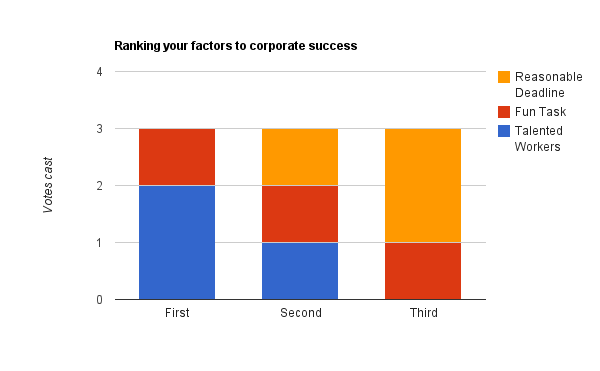I'm reworking an existing module which graphs results from a live survey with several different question types. I discovered that the results of matrix-type ranking questions are graphed as a single pie chart (apparently representing the proportion of first-rank votes for each item, ignoring the rest of the data).
Considering different ways of representing these data in a more complete way, I considered generating a multiple column chart, either side-by-side or stacked. While I decided on stacked, I'm somewhat torn between grouping the data by item or by rank. Here's an example data set I concocted (n = 3):
For tajmo, codeinthehole, Sure! Here's (a new) mock data table used to generate all of the charts (which have been re-done) showing number of votes received for each element:
Talented Workers Fun Task Reasonable Deadline
First 2 1 0
Second 1 1 1
Third 0 1 2
In this mock example, three participants vote to rank (by a ordering a series of draggable rows) their 'factors to corporate success' from among: having a talented workforce, having fun tasks to accomplish and being given reasonable deadlines. In this example, 2 people ranked "having talented workers" as their first choice, while no people ranked "having a reasonable deadline" as their first choice.
I have re-made the three graphs with this new data set (which is why they differ from previous versions of this question).
As I mention above, the first version of this module presented only the pie chart, showing the proportion of first-rank votes each item received.
I am tasked simply with "providing more information, probably in the form of bar charts" from these data.
My question centred around the best way to display this "more information". Since I chose to use a stacked bar chart, I'm left with the problem of grouping: is it conventional to group the data into:
- Bars of rank segmenting them by item; or
- Bars of item, segmenting by rank.
Grouped by item

Grouped by rank

The original first-rank pie chart was presumably implemented to focus attention on the proportion of votes cast for highest-ranked item. While there is a desire to provide more complete information, that original idea is still relevant. I believe the second graph, grouping by rank, best shows this trend.
What do you all think? Should I even consider a different graph type?
(While the possibility exists that the survey designer may provide a nearly unlimited number of items, they are practically limited to 6.)
As per dnbrv's request, here's a mock-up of what the current pie chart would look like. I believe the previously implemented charting function was done quickly, which is why it's functionality is limited, and not that they simply only care about the top ranked item. As in the first data set, this chart only plots the number of first-rank votes each item received (in a population of 3).

I imagined the answer to the question would be rather straightforward, which is why I didn't bother including the data table (especially as it's mock data anyway) or going into great detail about the surveying procedure. I hope these additions, and more clearly-labelled charts will help.


